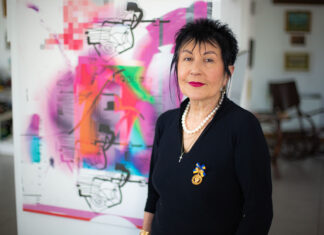Contemporary artists from the Armenian Diaspora
VENICE — In this symbolic year 2015, on the occasion of the centennial commemoration of the Armenian Genocide, the Ministry of Culture of the Republic of Armenia has dedicated its pavilion to the artists of the Armenian diaspora. It will be located at the Mekhitarist Monastery on the island of San Lazzaro degli Armeni. Vaporetti will leave for San Lazzaro every early afternoon from the Giardini.
The curatorial concept of armenity** implies the notion of displacement and territory, justice and reconciliation, ethos and resilience. Regardless of their place of birth, the selected artists carry within their identity the memory of their origins. Through their talent and willpower, these grandchildren of survivors of the Armenian Genocide — the first genocide of the 21st Century—rebuilt a “transnational assembly” from the remnants of a shattered identify. Their ingrained concern for memory, justice and reconciliation skillfully transcends notions of territory, borders and geography. Whether they were born in Beirut, Lyon, Los Angeles, or Cairo and wherever they may reside, these global citizens constantly question and reinvent their armenity.
Participating artists are: Haig Aivazian, Lebanon/France; Nigol Bezjian, Syria/USA; Anna Boghiguian Egypt/Canada; Hera Büyüktaşçıyan, Turkey; Silvina Der-Meguerditchian, Argentina/Germany; Rene Gabri & Ayreen Anastas, Iran/Palestine/USA; Mekhitar Garabedian, Belgium; Aikaterini Gegisian, Greece; Yervant Gianikian & Angela Ricci Lucchi, Italy; Aram Jibilian, USA; Nina Katchadourian, USA/Finland; Melik Ohanian, France; Mikayel Ohanjanyan, Armenia/Italy; Rosana Palazyan, Brasil; Sarkis, Turkey/France; Hrair Sarkissian, Syria/UK.
The exhibit is curated by Adelina Cüberyan v. Fürstenberg.







